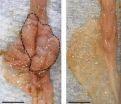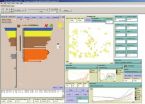(Press-News.org) New York, NY— Bacteria in the gut are essential for the development of intestinal tumors in mice, according to research led by investigators from the Icahn School of Medicine at Mount Sinai. Removing the bacteria may play a critical role in reducing cancer risk, the researchers write, in the March issue of the Journal of Experimental Medicine.
Sergio A. Lira, MD, PhD, Director of the Immunology Institute, and Professor of Immunology and Medicine, and his laboratory at the Icahn School of Medicine at Mount Sinai, used a transgenic mouse model to test the hypothesis that distribution of intestinal polyps (precancerous lesions) was dependent on the bacteria (or microbiota) in the gut. They treated the mice with antibiotics to eradicate the populations of bacteria living in the gut. The treatment proved effective in preventing polyp formation. The authors propose that bacteria cross from the gut into the tissue of the intestinal wall, promoting inflammation and tumor growth.
"This begins to get at some of the nongenetic factors that spur the development of colorectal cancer," said Dr. Lira. "Understanding the interplay between genetic mutations, gut bacteria, and inflammation may lead to new diagnostics and treatments for intestinal cancer."
INFORMATION:
National Institutes of Health grants 1R01CA161373-01 and P01 DK072201 provided funding to Dr. Lira for this research.
About the Mount Sinai Health System
The Mount Sinai Health System is an integrated health system committed to providing distinguished care, conducting transformative research, and advancing biomedical education. Structured around seven member hospital campuses and a single medical school, the Health System has an extensive ambulatory network and a range of inpatient and outpatient services—from community-based facilities to tertiary and quaternary care.
The System includes approximately 6,600 primary and specialty care physicians, 12-minority-owned free-standing ambulatory surgery centers, over 45 ambulatory practices throughout the five boroughs of New York City, Westchester, and Long Island, as well as 31 affiliated community health centers. Physicians are affiliated with the Icahn School of Medicine at Mount Sinai, which is ranked among the top 20 medical schools both in National Institutes of Health funding and by U.S. News & World Report.
For more information, visit http://www.mountsinai.org. Find Mount Sinai on: Facebook: http://www.facebook.com/mountsinainyc-Twitter @mountsinainyc YouTube: http://www.youtube.com/mountsinainy
Eliminating bacteria, changing lifestyle could lower risk in people genetically susceptible to colorectal cancer
2014-03-04
ELSE PRESS RELEASES FROM THIS DATE:
Standard-candle supernovae are still standard, but why?
2014-03-04
Sixteen years ago two teams of supernova hunters, one led by Saul Perlmutter of the U.S. Department of Energy's Lawrence Berkeley National Laboratory (Berkeley Lab), the other by Brian Schmidt of the Australian National University, declared that the expansion of the universe is accelerating – a Nobel Prize-winning discovery tantamount to the discovery of dark energy. Both teams measured how fast the universe was expanding at different times in its history by comparing the brightnesses and redshifts of Type Ia supernovae, the best cosmological "standard candles."
These ...
Virtual bees help to unravel complex causes of colony decline
2014-03-04
Scientists have created an ingenious computer model that simulates a honey bee colony over the course of several years. The BEEHAVE model, published today in the Journal of Applied Ecology, was created to investigate the losses of honeybee colonies that have been reported in recent years and to identify the best course of action for improving honeybee health.
A team of scientists, led by Professor Juliet Osborne from the Environment and Sustainability Institute, University of Exeter (and previously at Rothamsted Research), developed BEEHAVE, which simulates the life of ...
Sardis dig yields enigmatic trove: Ritual egg in a pot
2014-03-04
MADISON, Wis. — By any measure, the ancient city of Sardis — home of the fabled King Croesus, a name synonymous with gold and vast wealth, and the city where coinage was invented — is an archaeological wonder.
The ruins of Sardis, in what is now Turkey, have been a rich source of knowledge about classical antiquity from the 7th century B.C., when the city was the capital of Lydia, through later Greek and Roman occupations.
Now, however, Sardis has given up another treasure in the form of two enigmatic ritual deposits, which are proving more difficult to fathom than ...
World-class orchestras judged by sight not sound
2014-03-04
World-class orchestras can be accurately identified by silent video footage of performances, but not through sound recordings, a UCL study has found.
Both professional musicians and musical novices are better at identifying top-ranked orchestras from non-ranked orchestras when shown silent video footage, suggesting that such judgements are driven at least in part by visual cues about group dynamics and leadership.
When shown two 6-second clips, one from a world-class orchestra ranked among the top ten internationally - which included the London Symphony Orchestra, the ...
Plant extract offers hope for infant motor neurone therapy
2014-03-04
A chemical found in plants could reduce the symptoms of a rare muscle disease that leaves children with little or no control of their movements.
Scientists have found that a plant pigment called quercetin – found in some fruits, vegetables, herbs and grains – could help to prevent the damage to nerves associated with the childhood form of motor neuron disease.
Their findings could pave the way for new treatments for spinal muscular atrophy (SMA) – also known as floppy baby syndrome – which is a leading genetic cause of death in children.
The team has found that the ...
Yeast model reveals Alzheimer's drug candidate and its mechanism of action
2014-03-04
CAMBRIDGE, Mass. (March 3, 2014) – Using a yeast model of Alzheimer's disease (AD), Whitehead Institute researchers have identified a drug that reduces levels of the toxic protein fragment amyloid-β (Aβ) and prevents at least some of the cellular damage caused when Aβ accumulates in the brains of AD patients.
"We can use this yeast model to find small molecules that will address the underlying cellular pathologies of Alzheimer's, an age-related disease whose burden will become even more significant as our population grows older," says Kent Matlack, a former ...
Childhood adversity launches lifelong relationship and health disadvantages for black men
2014-03-04
AUSTIN, Texas — African American men who endured greater childhood adversity are likely to experience disadvantages in health and relationships over time, according to new sociology research from The University of Texas at Austin.
The study, published in the March issue of the Journal of Health and Social Behavior, helps to explain why African American men are less healthy than white men.
"Exposure to childhood adversity may cause stress and lead to a sequence of stressors over time that take a cumulative toll on relationships," says Debra Umberson, professor of sociology ...
Two studies examine bedroom TVs, active gaming and weight issues in children
2014-03-04
Bottom Line: Having a bedroom television is associated with weight gain in children and adolescents, and is unrelated to the time they spend watching.
Author: Diane Gilbert-Diamond, Sc.D., of the Geisel School of Medicine at Dartmouth, Lebanon, N.H., and colleagues.
Background: More than one-third of children and adolescents in the United States are overweight or obese. An estimated 71 percent of children and adolescents (ages 8 to 18 years) have bedroom televisions.
How the Study Was Conducted: The authors conducted a telephone survey in 2003 of 6,522 boys and girls ...
New research on potent HIV antibodies has opened up possibilities
2014-03-04
The discovery of how a KwaZulu-Natal woman's body responded to her HIV infection by making potent antibodies (called broadly neutralising antibodies, because they are able to kill multiple strains of HIV from across the world), was reported today by the CAPRISA consortium of AIDS researchers jointly with scientists from the United States.
The study, published in the prestigious scientific journal, Nature, describes how the research team found and identified these antibodies in her blood and then duplicated them by cloning the antibodies in the laboratory. The cloned antibodies ...
Distinctive flashing patterns might facilitate fish mating
2014-03-04
Scientists have shown for the first time that deep-sea fishes that use bioluminescence for communication are diversifying into different species faster than other glowing fishes that use light for camouflage. The new research indicates that bioluminescence—a phenomenon in which animals generate visible light through a chemical reaction—could promote communication and mating in the open ocean, an environment with few barriers to reproduction. The study was recently published in the journal Marine Biology.
"Bioluminescence is quite common in the deep sea, and many fishes ...





